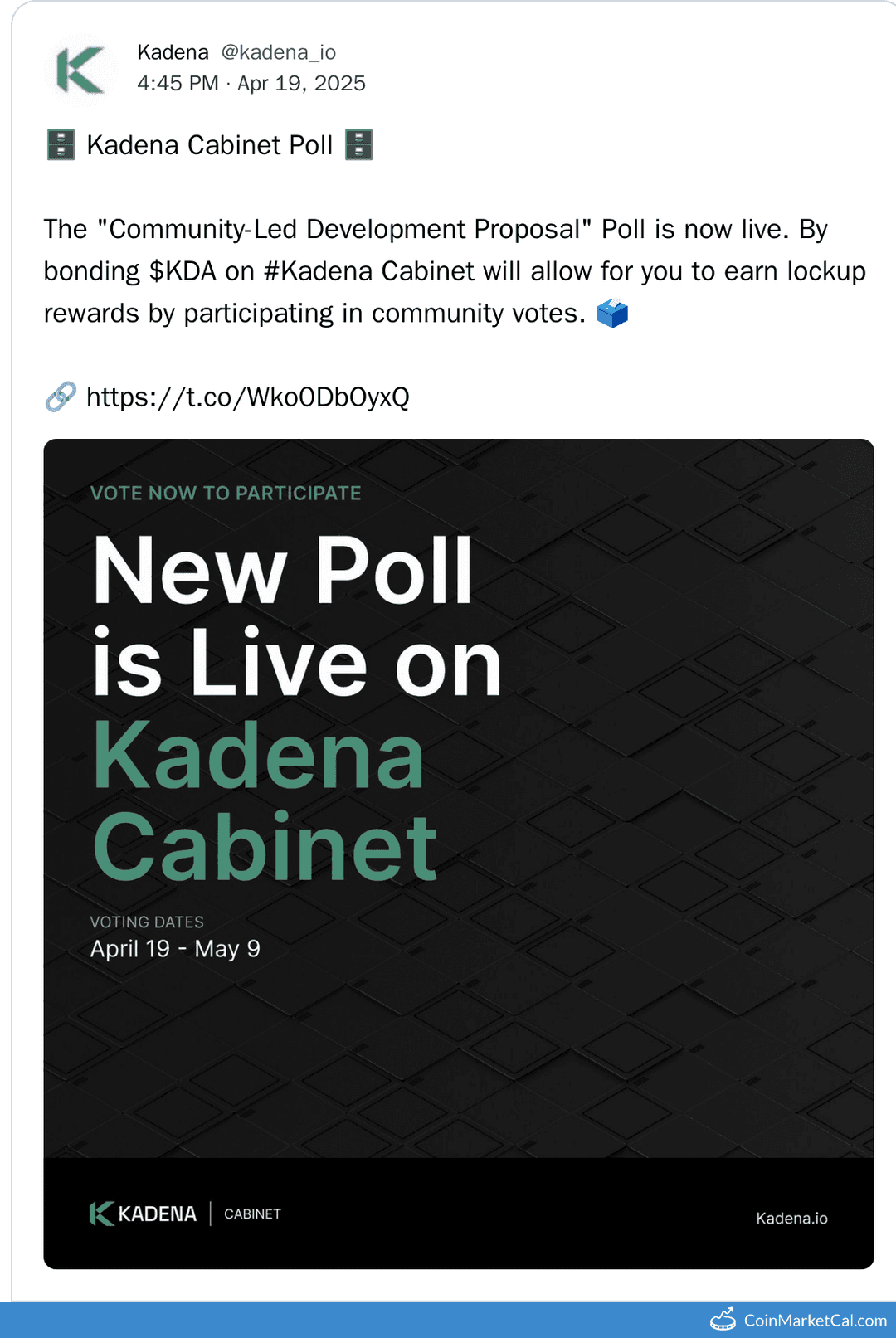Event Details and Significance
Kadena, a layer-1 blockchain platform known for its scalable Proof-of-Work (PoW) architecture called Chainweb, is hosting a community-led development proposal poll on its Kadena Cabinet platform from April 19 to May 9, 2025. This poll allows $KDA holders to participate in decision-making by bonding (locking) their tokens to vote on proposals and earn lockup rewards, as announced in an X post on April 19, 2025 [1]. Kadena Cabinet appears to be a governance feature where the community can influence the project’s future direction, aligning with Kadena’s ethos of decentralization and user empowerment.
The purpose of this event is to foster community engagement and ensure that development decisions reflect the interests of $KDA holders. By requiring users to bond $KDA, Kadena ensures that only committed stakeholders can vote, preventing spam and aligning voters’ interests with the project’s long-term success. The significance lies in promoting decentralized governance, a key principle in blockchain, which can strengthen community trust and ownership. The expected impact includes increased participation, potentially leading to more community-centric development, and possibly boosting $KDA’s utility and value as more users engage in governance.
Recent News and Developments
Over the past three months, Kadena has made significant strides, as highlighted in its 2024 Year in Review and recent X posts. Key developments include:
- Chainweb EVM Progress: Kadena is working on integrating Chainweb EVM, which will make its blockchain compatible with Ethereum’s Virtual Machine (EVM). This was emphasized in an X post by BSCN on April 22, 2025, noting that Kadena is poised for a massive year with this development, enabling Ethereum-based smart contracts and dApps on Kadena [2]. This move enhances interoperability and could attract more developers to the ecosystem.
- Strategic Advisor Appointment: On April 22, 2025, Kadena announced Chris Ngoi as a new strategic advisor, bringing expertise from traditional finance (TradFi) and his previous role at SC Ventures’ Libeara and KPMG. This hire aims to bridge the gap between TradFi and blockchain, potentially opening doors for institutional adoption [3].
- Community Engagement: Kadena’s focus on governance, as seen in the Cabinet Poll, aligns with its broader strategy of involving the community, as evidenced by recent AMAs and live sessions, such as one with BSCN on April 21, 2025 [6].
These developments highlight Kadena’s commitment to growth, interoperability, and community involvement, setting the stage for the Cabinet Poll.
Future Plans and Roadmap Highlights
Kadena’s roadmap for 2025 includes significant milestones, as outlined in its recent updates:
- EVM Compatibility: Becoming EVM compatible is a key goal, with Chainweb EVM expected to launch later in 2025. This will allow Kadena to support a broader range of decentralized applications, enhancing its appeal to developers and enterprises [2].
- Ecosystem Scaling: Kadena aims to scale its ecosystem by improving developer tools and onboarding more projects, leveraging its scalable Chainweb architecture, which can process up to 480,000 transactions per second [7].
- Governance Enhancements: The Cabinet Poll is part of a broader effort to refine governance mechanisms, potentially introducing more voting opportunities and rewards to incentivize community participation [1].
These plans position Kadena to compete with other layer-1 blockchains like Ethereum and Solana, particularly in enterprise and DeFi applications, by offering a scalable and interoperable platform.
Onchain Data and Market Trends
Kadena demonstrates steady onchain activity, with the following metrics as of April 2025:
- Token Metrics: As of recent data, $KDA has a market cap of approximately $463.1M USD, with a 24-hour trading volume of $8.99M USD, based on a circulating supply of around 1B $KDA [4]. The price is around $0.4631 USD, reflecting stable market interest.
- Network Activity: Kadena’s Chainweb architecture supports high throughput, with the potential for 480,000 transactions per second, though exact daily transaction volumes for April 2025 are not publicly detailed in the available data [7]. Its PoW consensus ensures security, and staking activity is implied through governance mechanisms like the Cabinet Poll.
Market trends show growing interest in layer-1 blockchains with EVM compatibility, as seen with competitors like Avalanche and Binance Smart Chain. Kadena’s focus on scalability and security, combined with its governance initiatives, positions it well to capture this demand, especially with enterprises seeking reliable blockchain solutions.
Additional Insights and User Benefits
Kadena’s Cabinet Poll offers significant benefits for $KDA holders. By participating, users can influence the project’s direction, earn rewards, and strengthen their stake in the ecosystem. Kadena’s unique Chainweb architecture, with its braided PoW chains, ensures high scalability and security, making it ideal for enterprise applications like supply chain and DeFi. The move towards EVM compatibility enhances developer accessibility, allowing for easier integration with Ethereum tools and dApps. Market trends indicate a rising demand for interoperable blockchains, and Kadena’s governance model, as seen in the poll, fosters community trust and alignment, appealing to both retail and institutional users.


